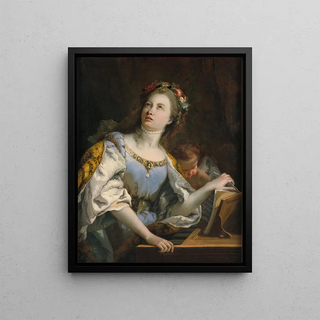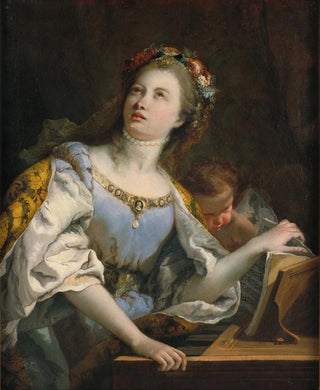Art print | Sainte Cécile - Giovanni Battista Tiepolo


View from behind

Frame (optional)
Sainte Cécile - Giovanni Battista Tiepolo – Engaging Introduction
In the vast panorama of art history, certain works manage to transcend time and space, captivating the collective imagination with their beauty and depth. "Sainte Cécile" by Giovanni Battista Tiepolo is one of these masterful creations. Painted in the 18th century, this artwork not only showcases the undeniable talent of its creator but also reflects the rich artistic tradition of the Baroque era. The depiction of the saint, surrounded by divine light, evokes a palpable spirituality, inviting viewers to introspective contemplation. This piece is a true hymn to music and faith, harmoniously blending the two in a scene full of life.
Style and uniqueness of the work
Tiepolo's style is distinguished by his bold use of color and light. In "Sainte Cécile," vibrant hues and delicate shadows blend to create an atmosphere that is both serene and dynamic. The composition is carefully orchestrated, with each element arranged with precision that demonstrates the artist's technical mastery. Tiepolo succeeds in capturing movement and emotion, making the scene almost alive. The drapery of the characters' clothing, with their fluidity and realism, adds a tactile dimension to the work, while the expressions on their faces reveal rare psychological depth. This ability to combine aesthetics and storytelling makes "Sainte Cécile" an emblematic work of its time, while remaining timeless.
The artist and his influence
Giovanni Battista Tiepolo, an emblematic figure of Venetian Baroque, left his mark on his era with a unique style that continues to influence many contemporary artists. Born in 1696, he established himself as one of the great masters of painting through his ability to create monumental frescoes and captivating paintings. His innovative approach to light and color paved the way for new artistic explorations, inspiring generations of artists across Europe. Tiepolo does not merely depict religious scenes; he weaves them with mythological and historical narratives, enriching the visual language

Matte finish

View from behind

Frame (optional)
Sainte Cécile - Giovanni Battista Tiepolo – Engaging Introduction
In the vast panorama of art history, certain works manage to transcend time and space, captivating the collective imagination with their beauty and depth. "Sainte Cécile" by Giovanni Battista Tiepolo is one of these masterful creations. Painted in the 18th century, this artwork not only showcases the undeniable talent of its creator but also reflects the rich artistic tradition of the Baroque era. The depiction of the saint, surrounded by divine light, evokes a palpable spirituality, inviting viewers to introspective contemplation. This piece is a true hymn to music and faith, harmoniously blending the two in a scene full of life.
Style and uniqueness of the work
Tiepolo's style is distinguished by his bold use of color and light. In "Sainte Cécile," vibrant hues and delicate shadows blend to create an atmosphere that is both serene and dynamic. The composition is carefully orchestrated, with each element arranged with precision that demonstrates the artist's technical mastery. Tiepolo succeeds in capturing movement and emotion, making the scene almost alive. The drapery of the characters' clothing, with their fluidity and realism, adds a tactile dimension to the work, while the expressions on their faces reveal rare psychological depth. This ability to combine aesthetics and storytelling makes "Sainte Cécile" an emblematic work of its time, while remaining timeless.
The artist and his influence
Giovanni Battista Tiepolo, an emblematic figure of Venetian Baroque, left his mark on his era with a unique style that continues to influence many contemporary artists. Born in 1696, he established himself as one of the great masters of painting through his ability to create monumental frescoes and captivating paintings. His innovative approach to light and color paved the way for new artistic explorations, inspiring generations of artists across Europe. Tiepolo does not merely depict religious scenes; he weaves them with mythological and historical narratives, enriching the visual language






